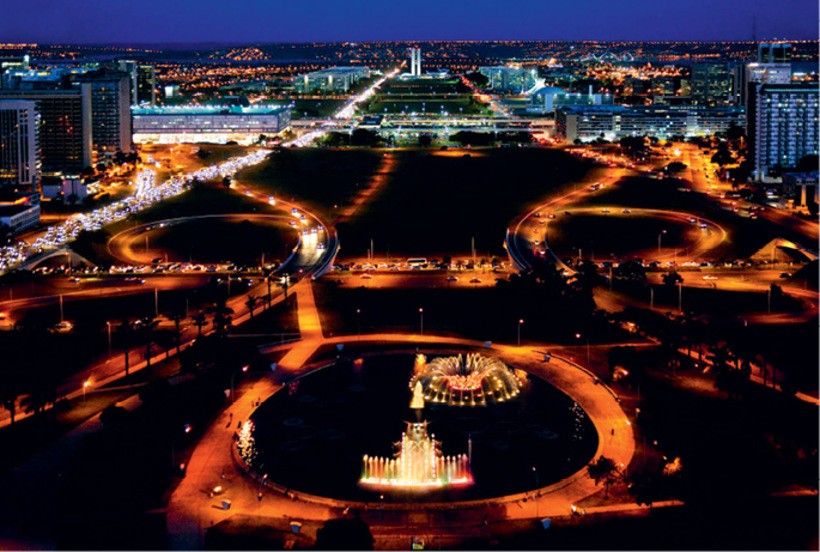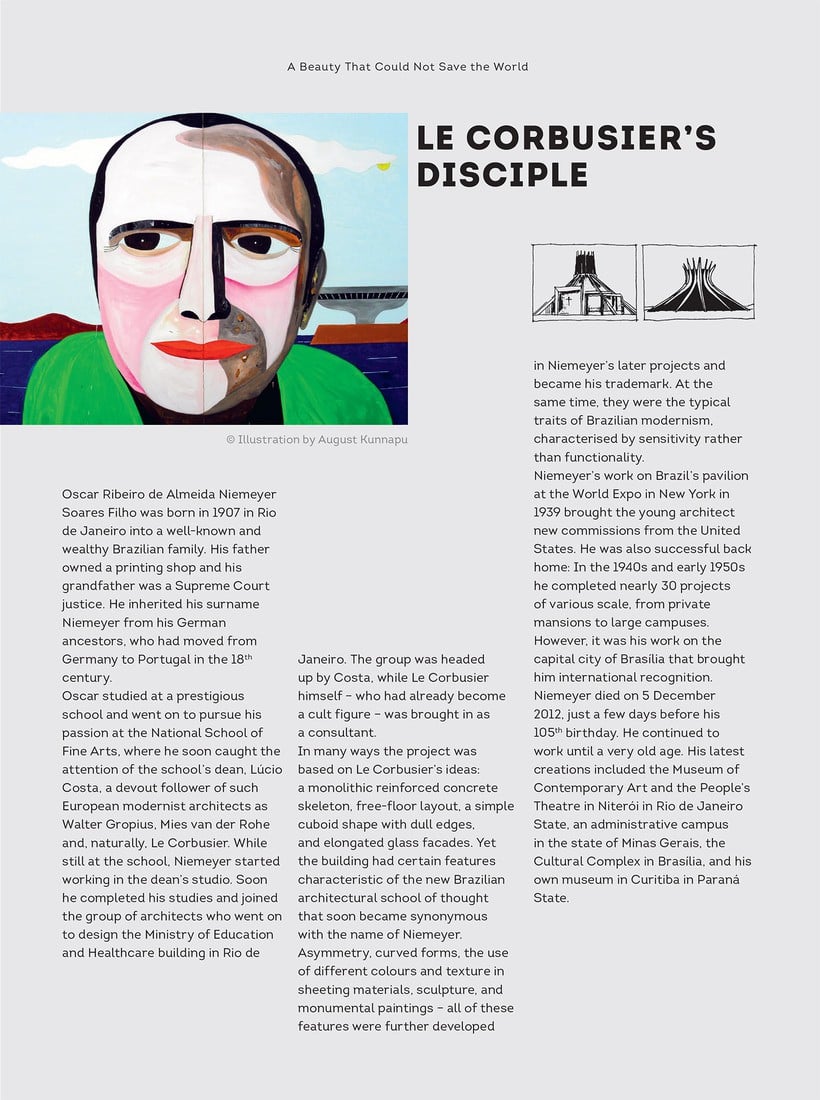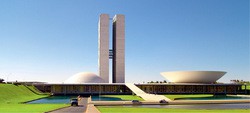A Beauty That Could Not Save the World
Oscar Niemeyer was one of the founders of the Brazilian modernist school of architecture. He also helped to design a new capital city, Brasília. Built on a desert plateau, the city became a perfect example of the modernist dream brought to life. It is both an architectural triumph of the 20th century and its greatest urban development failure.
Alexander Alexeev
The 20th century heralded an era of architectural utopias. Architects had always had the ambition not just to develop open spaces but also to create a social order. It is thanks to their talent and knowledge that the power of monarchs, the wealth of merchants, and the grandeur of deities found their visual, quotidian, manifestations. But against the backdrop of the last century’s large-scale social re-development experiments, architects suddenly realised that their hour to bring happiness to the whole of mankind was finally upon them. This realisation gave birth to modernism.
A clean slate
The idea to build Brazil’s new capital closer to the centre of the country was first voiced in the 1820s. However, it was only Juscelino Kubitschek – president of Brazil from 1956 to 1961 – who had the resolve to see it through. During his election campaign he promised that the city would be built before his presidential term ended; having won the election he immediately went on to implement his programme. His vision was to turn Brasília into a symbol of the country’s modernisation efforts, providing impetus for the development of its central region and becoming an example of a new kind of city, based on humanitarian values, which would be free of injustice, poverty and the infamous Brazilian slums called ‘favelas.’ In other words it was to become the opposite of the old Rio, shaped during the colonial era.
Oscar Niemeyer met Kubitschek in the early 1940s, long before he started working on the new capital project. At the time, the future president held the office of prefect in Belo Horizonte. He hired the architect to build an entertainment complex in an affluent city suburb, which included a casino, a dance hall and a yacht club. This project came as a turning point in Niemeyer’s career.
In 1956, Kubitschek requested his services again, inviting him to develop the master plan for the new capital. But Niemeyer turned down this offer, insisting on competitive bidding. Twenty-eight different projects were presented, with the successful bid coming from Niemeyer’s friend and mentor Lúcio Costa. Niemeyer, however, took on the design of government and public buildings himself.
From blueprint to reality
Viewed from the air, Brasília resembles an aeroplane or a bird, even though Costa claimed that he meant it to be reminiscent of a giant butterfly. Its head is a huge triangle: Three Powers Plaza. Its body is flanked on both sides by government buildings, ministries, a cathedral, a stadium and the city’s business, commercial and entertainment areas. Its spread wings are home to a maze of identical square-shaped residential quarters.
Kubitschek was an efficient president and surprisingly enough he kept his promise: Brasília was built in just three years by 60,000 construction workers. They used 100,000 tons of iron and a million cubic metres of concrete. Construction materials were flown in by plane, as roads were yet to be built.
In the summer of 1958, a group of architects had arrived in a capital city still under construction.
“One could not say that the conditions we found ourselves working in were satisfactory,” Niemeyer wrote later. “We had no electricity, no hot water and the food we ate during the entire period of construction left much to be desired. Torrential rains turned roads into mud, which was a great inconvenience for us as we were accustomed to asphalt roads. And yet, surprising as it may be, we were full of enthusiasm, resolve and fighting spirit.”
Kubitschek spared no expense in the construction and fully relied on the judgement of the architects. This helped him to avoid serious difficulties with the implementation of the initial vision. Naturally not everything went smoothly, but the main reason for difficulties was the furious pace at which the work was carried out. Finally, on 21 April 1960, Brasília officially took over from Rio de Janeiro as the nation’s capital.
The monumental buildings designed by Niemeyer adorn the sides of an esplanade that is as wide as an open field. These buildings look more like palaces – and that is precisely how they came to be known: the Palace of the Dawn, the Highland Palace, the Palace of Development, etc. Perhaps the city’s most famous landmark is the Palace of the National Congress, located on Three Powers Plaza. Two rectangular towers deliberately placed closely together to accentuate the empty spaces around them, a gigantic horizontal terrace resting on a low-rise building adorned by two parabolic structures – a dome and a cup; all of these elements contribute to a balanced architectural design. These simple laconic forms, the perfect proportion, and the snow-white sunlit surfaces contrasting with a blue sky and reddish soil, seem out of this world, bordering on the surrealistic.
The city’s residential buildings, however, were based on a standardised design. The multi-storey apartment blocks assembled together from pre-fabricated elements were the only realistic solution considering the tight construction deadlines. Moreover, this approach was fully in line with the legacy of Le Corbusier, who considered the modern home to be a ‘machine for living in.’ Yet a separate area of standalone villas was developed on the shores of the artificial Lake Paranoá.
Victory or defeat?
Costa and Niemeyer continued to work on Brasília’s development for several more years; however, after a new government came to power, their enthusiasm began to dwindle. Many original ideas had to be given up and their work turned into a series of conflicts with certain officials and even entire government agencies.
When a military dictatorship came to power in Brazil in the mid-1960s, Niemeyer was faced with a career crisis in his home country. He never managed to work in the United States; at the height of the Cold War the architect was denied a visa because of his communist views. He moved to Europe and continued to work in France and Algeria. He would return to Brazil from time to time to implement specific projects, but never saw eye to eye with the new administration. It was only in the 1980s, when a new democratic government came to power, that he finally returned home for good.
“The architect’s main objective is to dream,” wrote Niemeyer. Why is it that his own dream never came true? Why couldn’t this radiant city inspired by humanitarian ideals offer a comfortable life for everyone? Why did this splendid utopia never manage to come to life?
Jan Gehl, a popular urban planner, has even come up with two special terms – ‘Brasília Syndrome’ and ‘Helicopter Urbanism’ – to describe cities based on a plan which looks good from a bird’s eye view, but which does not work on the ground. Gehl also picked a strong word to describe the architects who practise this approach to city planning: he refers to them as ‘birdshit architects.’ The suggestion is that they draw up their plans looking down from high above and, like birds, tend to drop the results of their work on the heads of unsuspecting citizens
 This capital, built in the desert from scratch, also doubles as a wonderful metaphor for profound changes in a society: ‘We start a new life on Monday! … Granted, this new life is only likely to last until Wednesday evening, or Friday at the latest.’ The same rule applies to cities: they only look perfect on paper.
This capital, built in the desert from scratch, also doubles as a wonderful metaphor for profound changes in a society: ‘We start a new life on Monday! … Granted, this new life is only likely to last until Wednesday evening, or Friday at the latest.’ The same rule applies to cities: they only look perfect on paper.
Jan Gehl, a popular urban planner, has even come up with two special terms – ‘Brasília Syndrome’ and ‘Helicopter Urbanism’ – to describe cities based on a plan which looks good from a bird’s eye view, but which does not work on the ground. Gehl also picked a strong word to describe the architects who practise this approach to city planning: he refers to them as ‘birdshit architects.’ The suggestion is that they draw up their plans looking down from high above and, like birds, tend to drop the results of their work on the heads of unsuspecting citizens.
The truth is that cities built by modernists do look better from a distance. Large-scale structures separated by open spaces appear particularly stunning when viewed from a car speeding down a freeway.
Brasília never managed to become a city in the full sense of the word. According to Ricky Burdett, an urban planner from the U.K., it lacks complexity. Here you will not be able to find the mixture of residential, commercial and business functions characteristic of real cities. Brasília is divided into clear-cut zones and its street life is underdeveloped.
Despite all the efforts taken by various architects to make this project more humane and commensurate with the capacities of a normal human being, Brasília is not a very pedestrian-friendly city. Ironically, both the communist-minded planners and their capitalist counterparts placed greater emphasis on cars.
Brasília never had favelas, but soon after it was built a slum satellite city, called Taguatinga, sprang up nearby. Niemeyer and Costa may have envisaged that the capital’s labourers and construction workers would live in the very houses they built, but their dreams were never destined to come true. The high property prices in the capital proved too prohibitive, and Brasília soon turned into a city for the rich.
A splendid architectural idea alone proved to be incapable of eradicating poverty and injustice. Utopian urban projects developed by modernists ended up a failure because they never made room for the full extent of life’s complexities. Fortunately, these talented architects did not commit themselves exclusively to building ‘a brighter future’; they also created unique, expressive, and fluid structures.
“For me beauty always comes first,” said Oscar Niemeyer. So he did succeed in one thing beyond any doubt: He invented Brasília’s unique image. And many admired his architecture. In 1987 UNESCO declared Brasília a World Heritage Site, and the British architect Norman Foster has called it “hauntingly beautiful” and “absolutely magical”, “They make life richer for everybody who uses them.”












